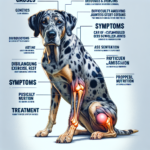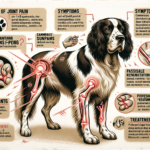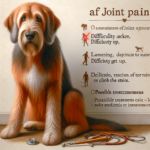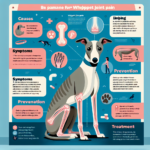Catahoula Leopard Dog Joint Pain: Causes, Symptoms, Prevention, and Treatment

Introduction
The Catahoula Leopard Dog, often simply referred to as the Catahoula, is a unique and versatile breed known for its striking coat patterns and exceptional working abilities. Originating from Louisiana, this breed was initially developed for hunting wild boar and herding livestock. Catahoulas are medium to large-sized dogs, characterized by their muscular build, webbed feet, and a short to medium-length coat that can come in a variety of colors and patterns, including the distinctive leopard-like spots.
While Catahoulas are generally healthy dogs, they are not immune to certain health issues. Common concerns include hip dysplasia, deafness, and eye problems. Among these, joint pain is a significant issue that can affect their quality of life. Given their active lifestyle and working background, maintaining joint health is crucial for Catahoulas to ensure they remain agile and pain-free.
Breed-Specific Joint Pain Risks
Genetic Predisposition
Catahoula Leopard Dogs are genetically predisposed to several joint-related issues. Hip dysplasia, a condition where the hip joint doesn’t fit properly into the hip socket, is particularly common. This can lead to arthritis and significant pain over time. Elbow dysplasia, another genetic condition, affects the elbow joints and can cause similar issues. Both conditions are hereditary, meaning that they can be passed down from parent dogs to their offspring.
Age-Related Risks
As Catahoulas age, the risk of developing joint pain increases. While younger dogs may show few signs of joint issues, older Catahoulas are more likely to develop arthritis and other degenerative joint diseases. Typically, signs of joint pain may start to appear around the age of 5 to 7 years, but this can vary depending on the individual dog’s genetics and lifestyle.
Activity Level and Joint Stress
Catahoulas are known for their high energy levels and are often used in demanding roles such as hunting, herding, and search and rescue. This high level of activity can put significant stress on their joints, especially if they are not given adequate rest or if they engage in high-impact activities like jumping or running on hard surfaces. Over time, this can lead to wear and tear on the joints, exacerbating any genetic predispositions to joint issues.
Common Symptoms of Joint Pain in Catahoula Leopard Dogs
General Symptoms
- Limping: One of the most noticeable signs of joint pain is limping or favoring one leg over another.
- Stiffness: Dogs may show stiffness, especially after resting or sleeping, which can improve with movement.
- Reluctance to Move: A dog in pain may be reluctant to engage in activities they once enjoyed, such as running or jumping.
- Swelling: In some cases, the affected joint may appear swollen or feel warm to the touch.
- Behavioral Changes: Dogs may become irritable or show signs of discomfort when touched near the affected joint.
Breed-Specific Symptoms
For Catahoulas, symptoms of joint pain may also include a noticeable decrease in their working or herding abilities. Given their high energy levels, a sudden drop in activity or enthusiasm for physical tasks can be a red flag. Additionally, due to their muscular build, any changes in muscle mass or tone around the joints can be indicative of underlying joint issues.
When to Consult a Vet
If you notice any of the above symptoms in your Catahoula, it is essential to consult a veterinarian. Early diagnosis and treatment can significantly improve the quality of life for dogs suffering from joint pain. Persistent limping, severe stiffness, or any signs of significant discomfort should prompt an immediate veterinary visit.
Preventive Measures for Joint Health
Exercise Recommendations
Regular, moderate exercise is crucial for maintaining joint health in Catahoulas. Activities such as swimming, walking on soft surfaces, and controlled play can help keep their joints flexible without causing excessive stress. Avoid high-impact activities like jumping or running on hard surfaces, which can exacerbate joint issues.
Dietary Suggestions
A balanced diet rich in essential nutrients can support joint health. Look for dog foods that contain glucosamine and chondroitin, which are known to promote joint health. Omega-3 fatty acids, found in fish oil supplements, can also help reduce inflammation and support overall joint function. Always consult your veterinarian before adding any supplements to your dog’s diet.
Weight Management
Maintaining a healthy weight is crucial for reducing joint stress. Excess weight can put additional pressure on the joints, exacerbating pain and leading to further complications. Regularly monitor your Catahoula’s weight and adjust their diet and exercise routine as needed to keep them at an optimal weight.
Early Screening and Monitoring
Regular veterinary check-ups are essential for early detection of joint issues. Screening tests such as X-rays can help identify conditions like hip or elbow dysplasia before they become severe. Early intervention can significantly improve the prognosis for dogs with joint issues.
Treatment Options for Joint Pain
Non-Surgical Treatments
Non-surgical treatments for joint pain in Catahoulas include medications such as non-steroidal anti-inflammatory drugs (NSAIDs) to reduce pain and inflammation. Physical therapy can also be beneficial, helping to strengthen the muscles around the joints and improve flexibility. Lifestyle adjustments, such as providing a comfortable bed and avoiding high-impact activities, can also help manage pain.
Surgical Options
In severe cases, surgical intervention may be necessary. Common surgeries for joint issues include hip replacement, arthroscopy to remove damaged tissue, and osteotomy to realign the bones. These procedures can be highly effective but come with risks and require a significant recovery period. Always discuss the potential benefits and risks with your veterinarian.
Alternative Therapies
Alternative treatments such as acupuncture, hydrotherapy, and massage can also provide relief for dogs with joint pain. Acupuncture can help reduce pain and inflammation, while hydrotherapy allows for low-impact exercise that can improve joint function. Massage can help relieve muscle tension and improve circulation around the affected joints.
Lifestyle and Management Tips
Daily Care Routine
A daily care routine for a Catahoula with joint pain should include gentle exercise, a balanced diet, and regular monitoring of their condition. Incorporate low-impact activities like swimming or walking on soft surfaces, and provide a comfortable, supportive bed to help alleviate joint stress.
Modifying the Home Environment
Making small changes to your home can significantly improve your dog’s comfort. Consider adding ramps to help them navigate stairs or get onto furniture without jumping. Orthopedic beds can provide additional support for sore joints, and non-slip mats can help prevent falls on slippery surfaces.
Long-Term Management
Long-term management of joint pain involves regular veterinary check-ups, ongoing weight management, and consistent use of any prescribed medications or supplements. Keeping your Catahoula active and engaged with low-impact activities can help maintain their quality of life despite joint pain.
FAQs About Catahoula Leopard Dogs and Joint Pain
What are the early signs of joint pain in Catahoulas?
Early signs of joint pain include limping, stiffness, reluctance to move, and behavioral changes such as irritability or discomfort when touched near the affected joint.
Can joint pain in Catahoulas be prevented?
While genetic predispositions cannot be entirely prevented, maintaining a healthy weight, providing regular low-impact exercise, and ensuring a balanced diet rich in joint-supporting nutrients can help reduce the risk of joint pain.
Are there specific exercises that are better for Catahoulas with joint pain?
Yes, low-impact exercises such as swimming, walking on soft surfaces, and controlled play are ideal for Catahoulas with joint pain. Avoid high-impact activities like jumping or running on hard surfaces.
What dietary supplements can help with joint health in Catahoulas?
Supplements containing glucosamine, chondroitin, and omega-3 fatty acids can support joint health. Always consult your veterinarian before adding any supplements to your dog’s diet.
When should I consider surgery for my Catahoula’s joint pain?
Surgery should be considered when non-surgical treatments are no longer effective, and the dog’s quality of life is significantly impacted. Consult your veterinarian to discuss the potential benefits and risks of surgical intervention.
Conclusion
Joint pain is a significant concern for Catahoula Leopard Dogs, given their active lifestyle and genetic predispositions. By understanding the causes, symptoms, and preventive measures, owners can take proactive steps to ensure their dog’s joint health. Regular veterinary check-ups, a balanced diet, and appropriate exercise are crucial for maintaining joint function and overall well-being. If joint pain does develop, a range of treatment options, from medications to surgery and alternative therapies, can help manage the condition and improve the dog’s quality of life. Always consult your veterinarian for personalized advice and treatment plans to keep your Catahoula happy and healthy.




